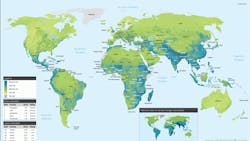Back in 1971, former Beatle George Harrison organized the first blockbuster benefit concert to raise money and awareness for the people of Bangladesh, whose country had been ravaged by a tropical cyclone said at the time to be the deadliest of its kind. More than a half-million people were killed in the disaster, and the effects of the storm were exacerbated by the country's Third World infrastructure (i.e., there wasn't much of it) and its political volatility.
Today, nearly 40 years later, Harrison has passed away and not much has changed with Bangladesh. According to a study conducted by risk analysis firm Maplecroft, Bangladesh is the country most vulnerable to the effects of climate-related natural disasters.
Maplecroft's Climate Change Vulnerability Index (CCVI) is used by global manufacturers to identify areas of risk within their operations, supply chains and investments. The index is calculated using 42 separate social, economic and environmental indicators, including exposure to climate-related natural disasters; population patterns; agricultural dependency; conflicts; and the adaptive capacity of a country's government and infrastructure to combat climate change. It ranks 170 countries on their relative susceptibility to the impacts of climate change over the next 30 years.
Of the 16 countries identified as extreme risks, several are Asian nations considered among the world's fastest growing economies, most of which are seen as low-cost manufacturing alternatives to China. In addition to Bangladesh, other "extreme risk" Asian countries include India (ranked No. 2), the Philippines (6), Vietnam (13) and Pakistan (16).
"These countries are attracting high levels of foreign investment from many multinational organizations," notes Matthew Bunce, principal analyst at Maplecroft. "However, over the next 30 years their vulnerability to climate change will rise due to increases in air temperature, precipitation and humidity. This means organizations with operations or assets in these countries will become more exposed to associated risks, such as climate-related natural disasters, resource security and conflict. Understanding climate vulnerability will help companies make their investments more resilient to unexpected change."
Mirroring conditions substantially unchanged since the country was founded in 1971, Bangladesh's ranking as the country most at risk is attributed to extreme levels of poverty, a high dependency on agriculture and a government ill-prepared to adapt to predicted climate changes. As recently as October 2010, 500,000 people were affected by severe flooding. Even so, the country's economy has seen rapid growth during the past decade, expanding 88% between 2000 and 2008, with a growth rate expected to reach 6.2% over the next five years.
The lowest-risk countries, incidentally, include all four Scandinavian countries, as well as Iceland and Ireland. The United States finished with a ranking of 129, and is considered a "medium-risk" country.
See Also:
• Supply Chain Earns a Seat at the Table
About the Author
Dave Blanchard
Senior Director of Content
Focus: Supply Chain
Call: (941) 208-4370
Follow on Twitter @SupplyChainDave
During his career Dave Blanchard has led the editorial management of many of Endeavor Business Media's best-known brands, including IndustryWeek, EHS Today, Material Handling & Logistics, Logistics Today, Supply Chain Technology News, and Business Finance. He also serves as senior content director of the annual Safety Leadership Conference. With over 30 years of B2B media experience, Dave literally wrote the book on supply chain management, Supply Chain Management Best Practices (John Wiley & Sons, 2010), which has been translated into several languages and is currently in its second edition. He is a frequent speaker and moderator at major trade shows and conferences, and has won numerous awards for writing and editing. He is a voting member of the jury of the Logistics Hall of Fame, and is a graduate of Northern Illinois University.
